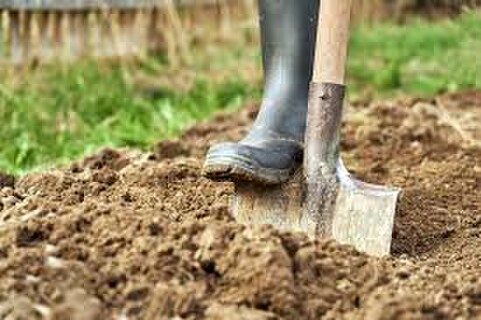Unlock the nutrients in clay
Squelching about in the muddy clay soil might be fun when you're five years at, but not so much at fifty five (or at any age when you decide to get serious about planting and gardening).
Discovering your little bit of paradise turns into a soggy, boggy clay mess in the wet months and then dries out and cracks open in the dry months is a sad moment for many New Zealand gardeners. But should it be?
No. Because clay soil is actually packed full of beneficial nutrients that your plants will love, AND it retains moisture, which plants also need to thrive. But...
The problem lies with the fine texture and dense structure of clay soil. The very small particles stick together, locking in those lovely nutrients and making them unavailable to your plants.
The density of the 'stuck together' soil means air and water can’t move freely through the soil, this resistance causes the water logging (let's call that 'swelling'), and slow drainage.
Then, as water evaporates from the soil (due to heat, low humidity, wind etc), the clay particles lose all that ollected water and 'shrink', and that's what causes it to crack.
The good news, is that it can be remedied!
Two things to do when gardening in clay soil
There are two key things to do when gardening in clay soil.... and you need to do both!
Short term : Modify some of the soil to facilitate planting
Long term: Improve the texture of the remaining garden soil
Improving soil takes time and there is no magic bullet, so if you are keen to just get going with your planting, start by modifying soil in those areas, such as planting holes and vegetable gardens.
FAST SHORT TERM SOLUTIONS
Create raised or mounded garden beds. This is a great way to facilitate fast, successful planting into water-logged or cracking soils, as it helps to keep roots clear of very wet soil and provides ettter growing conditions, as you can backfill the areas with nutritious, free-draining garden mix or soil mixes. This is also a great way to get vegetable gardens sown in spring, as clay soils are notoriously slow to warm up.
For larger projects or areas that won't suit rasied gardens solutions create modified, individual planting holes for each plant. Dig these holes to around twice the width and depth of the root ball of the plant, then crumble some of the clay and put back in the hole, mixing it with good quality commercial soil mixor compost. It’s vital the plants are planted at the same depth as they were in their nursery pot, to avoid collar rot. You can find more detail on 'how to plant' in the DIY Planting Guide' that comes FREE with any of our plant combo guide e-books.
Improve planting niches, but don't stop there.
Larger plants will eventully outgrow these lovely planting niches you have created, and their strong root systems will make their way down into the deeper clay soils, taking with them some of the modified soil, and worms and micro-organisms will also be busy aerating and mixing the soilsimmediately surrounding the planting hole, breaking up the dense soil structure and making it easier for plant roots to spread and access food and moisture.
BUT, you also need to work on long-term improvements on the surrounding soils, which will aid future planting projects.
One of the first things to do if you have clay soil is to add a clay-breaker product. Topical applications of Gypsum have long been the go-to for gardeners (including me) desperate for help with breaking down those sticky clay particles., and it works for lawn areas too. IGypsum (also sold under other brand names such as 'Clay Breaker') is an environmentally friendly, natural mineral that, when it dissolves, slowly releases equal amounts of calcium and sulphate into the soil. If your soil is a very heavy clay, more than one application may needed. It doesn't work overnight, so do it as soon as you can. You can buy Gypsum from the hardware store or garden centre, and just follow the instuctions on the packet!
Adding organic matter is essential, as it will help break up that dense structure, this can be things such as well rotted (or bagged) compost, comost mulches, manure, finely shredded bark, seaweed or straw. Add about 7 -10cm and, if you can, lightly mix it into the top layer of soil to break it up, going about as deep as the head of the spade. Repeat this overtime as the organic matter rot down and become incorporated into the soil. This helps lighten the soil structure, resulting in better drainage in wet weather (ie less swelling) and better moisture retention in dry or windy conditions (ie less shrinking).
If you can't dig the organic matter in because the soil is too boggy or cracked, don't worry, you can just lay it on top and then nature take its course. Overtime moving to this ‘no-dig’ system is best anyway, as it doesn’t disturb the work of beneficial microorganisms and insects.
The no-dig method is great if digging isn’t your thing, or if the gardens are too established to dig over. Just layer that organic mulch on top of the soil. Even once your soil starts to improve, this surface 'mulching' is worth doing, as it helps prevent evaporation and retain moisture in the dryer months. Mulch also helps slow weed establishment in the absence of groundcover plants. Make mulch layers around around 5 - 10cm thick, and reapply annually as layers down or get worked into the soil by those industrious worms and micro organisms.
Key things for improving clay soil
As you go about improving clay soil, remember these important things:
Clay soil compacts easily, (which makes it heavier and exacerbates drainage problems), so never dig or plant in clay soil when it is wet. Damp soil is best.
Keep off your clay soil when it is wet or you'll compact it even more. Use boards or pavers to distribute your weight if you are laying mulch.
Autumn and spring are great times to dig in and incorporate organic matter, because the soil is more moist, without the extremes of boggy or dry.
In colder areas, after autumn digging you can leave the soil surface in ridges over winter,. Frost will get in and break up the clumps.
Plant woody shrubs and trees on soil mounds to encourage water run off, helping keep roots clear of very wet soil.
Don’t add sand to clay soil without doing your research. It requires a significant amount of sand (around 50% of the soil volume) to be effective and without sufficient sand, the clay can fill in the spaces between the sand particles, potentially worsening compaction and drainage.
Organic matter is the most effective amendment for clay soil, as it improves both drainage and nutrient retention.
Lots of plants flourish regardless.
If it all sounds like too much hard work, don’t despair.... instead opt for plants that will thrive in clay soil.
For shrubs and perennials - the list includes many old favourites...
Roses
Hydrangea
Dahlia
Cranesbill geraniums
Salvia
Hosta
Clivia
Looking for trees and shrubs: Try....
Magnolia
Cornus
Alder
Birch
Prunus
Philadelphus
Viburnum
Thuja
If NZ native plants are more up your garden alley consider;
Flax
Oioi
Cabbage trees
Manuka
Avoid plants with silver foliage, as this is an indicator of a drought tolerant plant, which means they'll be more useptible to rotting in wet conditions.


